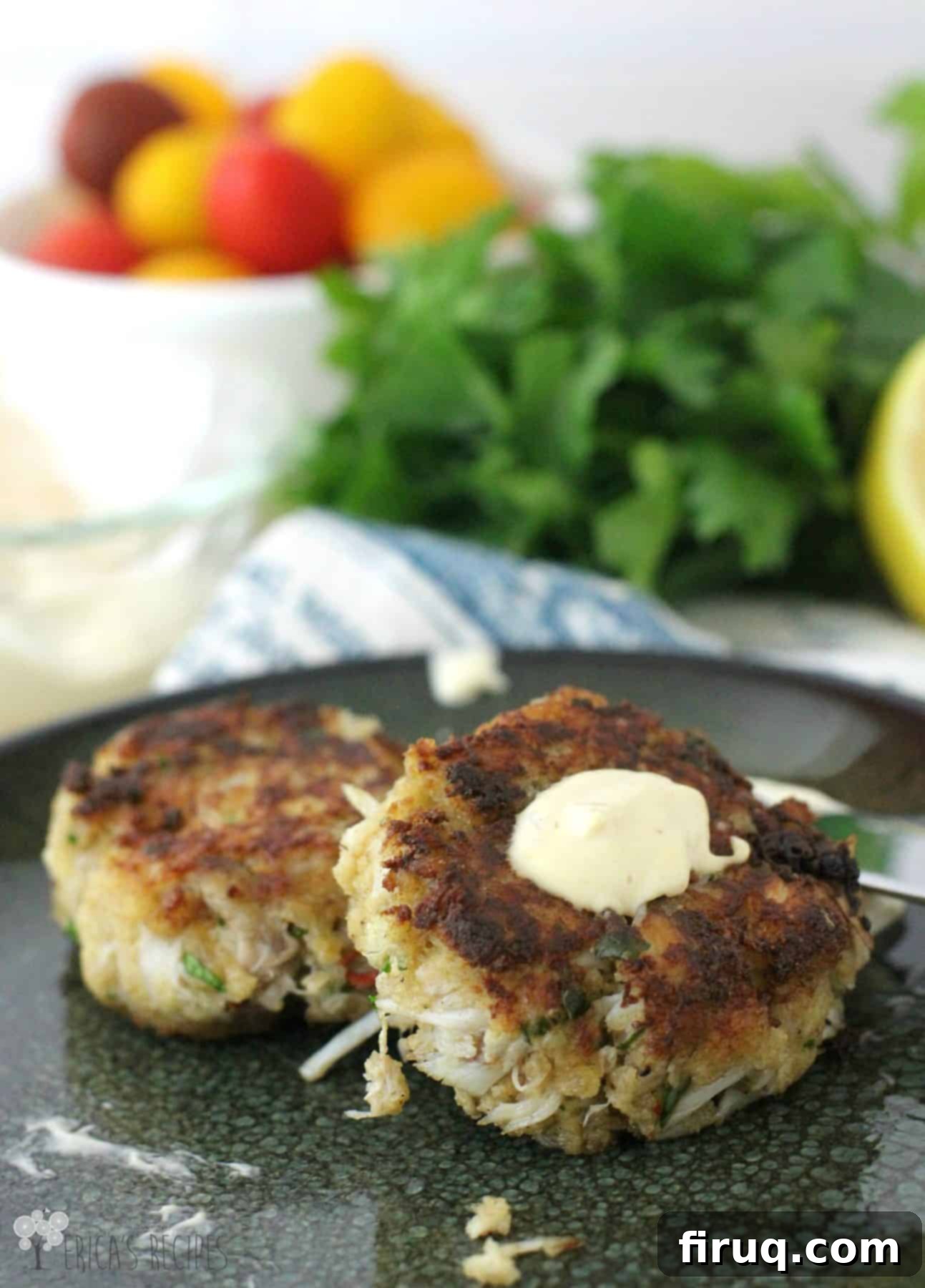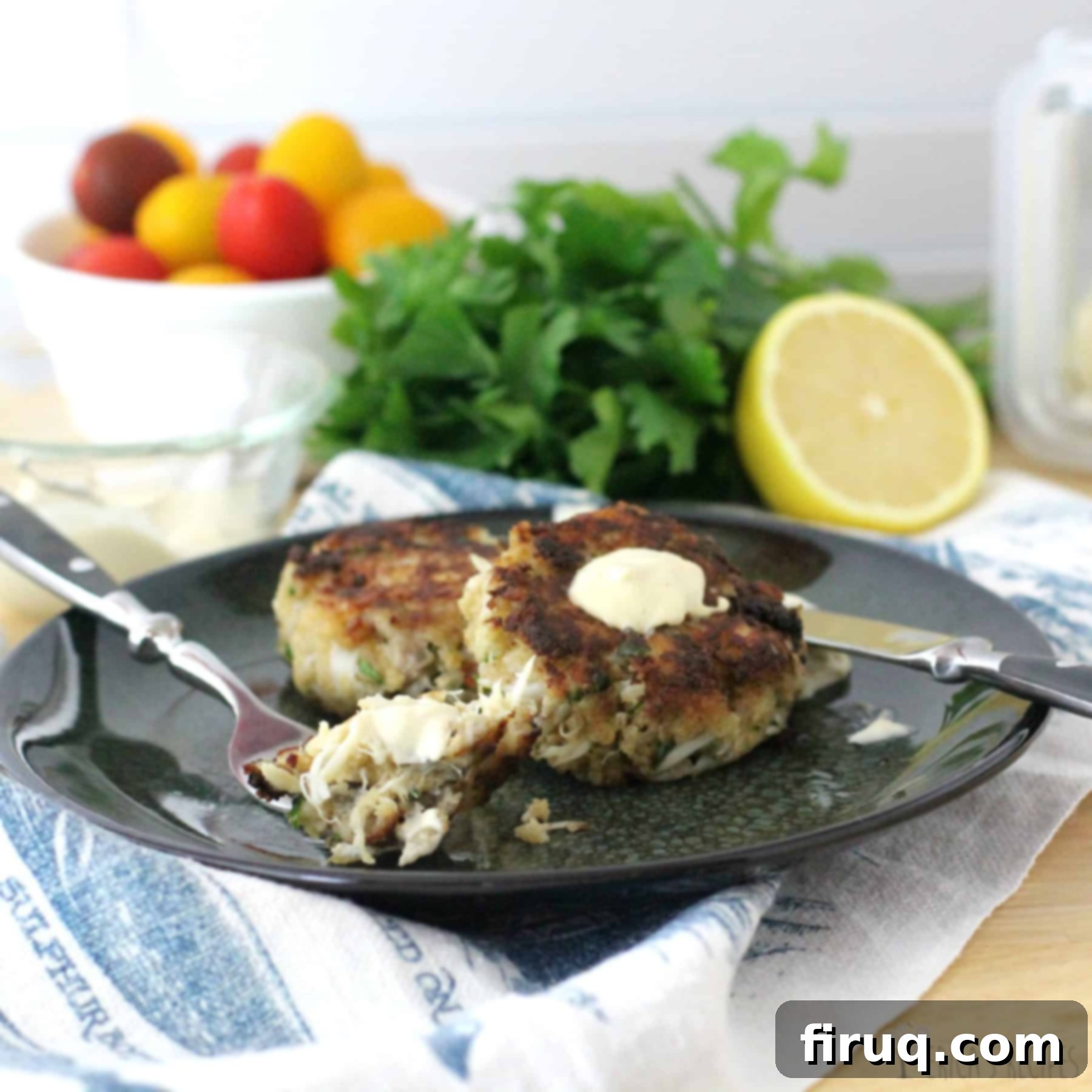Mastering New England-Style Crab Cakes with Zesty Dijon-Horseradish Aioli: The Perfect Seafood Delicacy
There’s nothing quite like the indulgence of perfectly crafted crab cakes. And when it comes to a classic, the New England-style crab cake, served with a vibrant and tangy Dijon-Horseradish Aioli, stands in a league of its own. This recipe offers a delightful culinary journey, balancing the sweet, delicate flavors of fresh lump crab with just the right amount of savory seasoning and a hint of zesty heat from its accompanying sauce. It’s a dish that evokes coastal charm and sophisticated comfort, making it ideal for a special occasion or a memorable weeknight meal.

Every seafood lover knows the joy of a good crab feast. Sometimes, however, our enthusiasm at the market outpaces our appetites at the dinner table. So, what’s a savvy cook to do with an abundance of delicious, extra steamed blue crabs when you’re simply too full to eat another bite? The answer, my friends, is simple and profoundly satisfying: pick those suckers clean and transform that pristine crab meat into the most incredible crab cakes you’ve ever tasted!
This culinary adventure often begins with a cherished family tradition, much like ours, where one night a week is dedicated to going a little “seafood crazy.” And, as mentioned, sometimes our eyes are indeed bigger than our stomachs. With a recent batch of Classic Steamed Blue Crabs, this delightful dilemma presented itself. Thankfully, it was an entirely welcome situation, as crab cakes happen to be one of my absolute favorite foods. They represent the epitome of seafood comfort, versatile enough to be a sophisticated appetizer or a star main course.
The Great Crab Cake Debate: New England vs. Maryland and Finding the Perfect Balance
When it comes to crab cakes, I believe it’s no-joke, serious business. And at the heart of this seriousness lies the age-old, fiercely debated question: how much filler should there be? You know, the ingredients in the cakes other than the glorious crab itself. This particular culinary divide often traces geographical lines.
I hail from New England, a region that traditionally embraces a certain amount of filler in its crab cakes. This approach often incorporates various binders and seasonings to create a cohesive, flavorful patty. However, it can sometimes lead to an unfortunate overzealousness with ingredients. On the other side of the spectrum is my husband, a proud Maryland native, whose philosophy leans towards minimal filler, showcasing the pure essence of the crab.
Critiquing the Extremes: Why Too Little or Too Much Filler Misses the Mark
While I respect the traditions, I must confess my personal preferences. When I lived in Maryland and encountered crab cakes with practically “zilch filler,” they were, to my palate, essentially fried balls of straight, pure crab. And honestly, they simply weren’t tasty. (Awww snap, no she di’n’t!)
Yes, I did. I do not favor the extreme Maryland-style crab cakes that prioritize only crab, often sacrificing texture and complementary flavors. While the purity of crab is commendable, a touch of thoughtful binding and seasoning elevates the experience. However, the pendulum can swing too far the other way. Up north, folks sometimes get overzealous with their ingredients, going heavy-handed with the filler, and that doesn’t work for me either. New England, I love you, but bell pepper has absolutely no place in crab cakes. And they certainly shouldn’t be mostly breading, either! The goal is to highlight the crab, not bury it under an avalanche of other ingredients.
My Solution: The Best of Both Worlds for Unforgettable Crab Cakes
My culinary solution is to intelligently take the best aspects from both regional approaches. I add filler, yes, but I keep it simple, purposeful, and complementary. The star of the show, of course, must always be the crab itself. For this, I insist on using high-quality lump blue crab. Its sweet, delicate flavor and flaky texture are unparalleled and form the perfect foundation for truly exceptional crab cakes.
To bind and enhance, I incorporate a carefully selected blend of ingredients. A little fresh herb, some classic seasoning, and a crucial component: panko breadcrumbs. Panko is a game-changer because it provides a lighter, crispier texture and holds up beautifully during cooking without becoming grainy like dried breadcrumbs or pasty like fresh ones. Finally, an egg acts as the perfect binder, ensuring the cakes hold their shape while remaining moist and tender. This thoughtful combination results in a crab cake that is neither overwhelmed by filler nor lacking in structural integrity or nuanced flavor. Top these perfectly balanced cakes with a traditional, vibrant aioli, and now we’re truly talking culinary excellence.
This recipe, in a snap, produces crab cakes that are truly restaurant quality. They are incredibly delicious, boasting just the right balance of ingredients – and, yes, the perfect amount of thoughtfully chosen filler. Each bite delivers a harmonious blend of sweet crab, savory seasonings, and a satisfying texture that will leave you craving more. The simplicity of the method belies the sophisticated flavor profile achieved, making this a go-to recipe for any seafood enthusiast.

Crab Cakes with Dijon-Horseradish Aioli
Print
Pin
Rate
Ingredients
For the crab cakes
- 1 lb fresh lump crabmeat preferably blue crab
- 1 cup panko breadcrumbs
- 1 Tbs chopped fresh parsley
- 2 Tbs mayonnaise
- 1 Tbs fresh lemon juice
- 1 tsp Old Bay
- 2 tsp Grey Poupon Country Dijon Mustard
- 1 tsp Worcestershire sauce
- ½ tsp onion powder
- 1 egg lightly beaten
- 2 Tbs unsalted butter
- 2 Tbs extra virgin olive oil
- fresh squeezed lemon if desired
For the Dijon-Horseradish Aioli
- ½ cup mayonnaise I use olive oil-based mayo
- 1 Tbs Dijon mustard
- couple sprinkles Worcestershire sauce
- ½ tsp prepared horseradish
- pinch kosher salt
Instructions
-
Combine the ingredients for the aioli in a small bowl. Chill until ready to serve.
-
In a bowl, combine all the ingredients up to and including the egg. Toss together lightly with a fork so that the crab doesn’t completely break apart. Using your hands, form the crab mixture into 8 patties.
-
Heat a large, nonstick over medium-high heat. Add the butter and olive oil, and wait for the butter to stop frothing. Using your hands, take a palmful of the crab mixture and form into a patty. Gently lay 4 formed crab cakes into the oil and cook until browned on one side. Gently flip over each crab cake and brown the other side. Remove to a plate. Cook the remaining 4 crab cakes. Serve with Dijon-Horseradish Aioli and fresh squeezed lemon. Yield: 8 crab cakes; 4 servings.
The Essential Dijon-Horseradish Aioli: A Perfect Partner
No crab cake experience is complete without the perfect accompanying sauce, and our Dijon-Horseradish Aioli is designed to elevate every bite. An aioli is fundamentally a garlic-infused mayonnaise, but ours takes a delightful turn with the addition of pungent Dijon mustard and a kick of prepared horseradish. This combination is not arbitrary; each ingredient plays a critical role in creating a harmonious counterpoint to the rich, sweet crab cakes.
The creamy base of mayonnaise (preferably an olive oil-based variety for a healthier touch and smoother flavor) provides a luxurious mouthfeel. The Dijon mustard introduces a sharp, tangy note that cuts through the richness of the fried crab cakes, awakening the palate. Meanwhile, the prepared horseradish offers a subtle, yet invigorating heat that adds an exciting dimension without overwhelming the delicate crab. A few sprinkles of Worcestershire sauce further deepen the savory notes, and a pinch of kosher salt brings all these vibrant flavors into perfect balance. This aioli is simple to whisk together and only improves as it chills, allowing the flavors to meld beautifully. It’s the ideal cool, creamy, and zingy complement to the warm, crispy crab cakes.
Tips for Achieving Crab Cake Perfection Every Time
Creating these sensational New England-style crab cakes is an art, but it’s an accessible one. Here are a few tips to ensure your crab cakes turn out perfectly:
- Quality Crab is Key: Always start with the freshest lump blue crab meat you can find. The quality of your crab will directly impact the flavor of your finished dish. Gently pick through it to remove any shell fragments without breaking up the lumps too much.
- Gentle Mixing: When combining the crab with the other ingredients, use a light hand and a fork. Overmixing will shred the beautiful lumps of crab and result in a mushy texture. You want to preserve those distinct pieces of crab meat for the best mouthfeel.
- Consistent Patties: Form your crab mixture into uniform patties. This ensures even cooking, so all your crab cakes are golden brown and perfectly cooked through at the same time. Don’t press them too firmly; a light touch is best.
- Proper Pan Temperature: Heating your nonstick skillet over medium-high heat is crucial. The combination of butter and olive oil adds flavor and helps achieve a beautiful golden-brown crust. Wait for the butter to stop frothing before adding the crab cakes; this indicates the pan is at the right temperature for searing.
- Don’t Crowd the Pan: Cook the crab cakes in batches, typically 4 at a time, to avoid overcrowding the pan. Crowding lowers the oil temperature, leading to steaming instead of searing, which prevents that desirable crispy exterior.
- Serve Immediately: Crab cakes are best enjoyed fresh from the pan, while they are warm and the crust is still delightfully crispy.
Serving Suggestions Beyond the Aioli
While the Dijon-Horseradish Aioli is a stellar partner, these versatile crab cakes can be served with a variety of accompaniments. A simple squeeze of fresh lemon juice over the top provides a bright, acidic counterpoint that enhances the crab’s natural sweetness. For a light meal, serve them alongside a crisp green salad with a vinaigrette dressing. They also make an excellent appetizer for a dinner party, perhaps with some fresh asparagus or a light slaw. For a more substantial main course, consider pairing them with roasted potatoes or a medley of seasonal vegetables. The possibilities are endless when you have such a delicious and adaptable foundation.
Whether you’re making these crab cakes from leftover steamed crabs or starting with fresh lump crab meat, you’re in for a treat. This recipe promises a New England classic with a perfectly balanced flavor and texture that will impress and delight. Enjoy the process of creating these culinary gems, and savor every exquisite bite!

